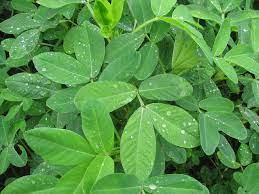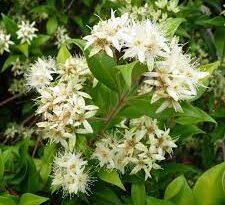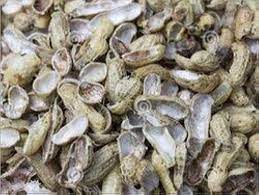Economic Importance, Uses, and By-Products of Groundnuts/Peanuts Leaves
Groundnuts/Peanuts Leaves, also known as peanuts, are a legume crop widely cultivated for their seeds, which develop underground, and their above-ground leaves. The leaves of the groundnut plant have several distinct characteristics:
Groundnut leaves are compound leaves, meaning each leaf is composed of multiple leaflets. Typically, there are four leaflets per leaf, arranged in pairs opposite each other, with an odd one at the tip.
The individual leaflets are oval or lance-shaped, with a pointed tip and a slightly serrated (toothed) edge.
The color of groundnut leaves varies depending on the specific variety and growing conditions. They are generally a bright green shade, but the intensity can differ based on factors such as sunlight exposure and soil nutrients.
The leaves are arranged alternately along the stem, meaning that each leaf emerges from a different point on the stem in an alternating pattern.
Groundnut leaves can vary in size, with mature leaves usually ranging from 2 to 5 inches (5 to 12 centimeters) in length and 1 to 2 inches (2.5 to 5 centimeters) in width.
The leaves have a relatively smooth texture, and the surface is covered in fine hairs or trichomes, which can give them a slightly fuzzy appearance.
ike other plant leaves, groundnut leaves play a crucial role in photosynthesis. They contain chlorophyll, a pigment that captures sunlight to convert carbon dioxide and water into energy-rich sugars, which the plant uses for growth and development.
While groundnut leaves are primarily valued for their seeds, the leaves are not commonly consumed by humans. However, they can be used as animal fodder or added to compost to enrich the soil.
It’s worth noting that groundnut leaves are not commonly featured or sought after in culinary applications. Instead, it is the seeds (peanuts) that are widely used in various culinary preparations, oils, and snacks worldwide.
Economic Importance, Uses, and By-Products of Groundnuts/Peanuts Leaves

Groundnut leaves, also known as peanut leaves, have various economic importance and uses. While groundnut plants are primarily grown for their nuts, their leaves are not to be overlooked, as they offer several valuable applications. Here are some of the economic importance and uses of groundnut/peanut leaves:
1. Livestock Feed: Groundnut leaves serve as nutritious fodder for livestock, particularly ruminants like goats, sheep, and cattle. They are rich in protein, minerals, and vitamins, making them a valuable supplementary feed source. Farmers can use groundnut leaves to improve the diet of their livestock and enhance their growth and productivity.
2. Green Manure: Groundnut leaves can be used as green manure, a practice in agriculture where fresh plant materials are plowed into the soil to improve its fertility. As groundnut leaves decompose, they release nutrients into the soil, enriching it and enhancing crop yields in subsequent plantings.
3. Medicinal Uses: In some traditional medicine systems, groundnut leaves are used for their medicinal properties. They may be used in various remedies to treat ailments such as coughs, wounds, skin infections, and digestive issues. However, it’s important to note that their medicinal uses should be approached with caution, and consulting a qualified healthcare professional is essential for safe and effective use.
4. Culinary Applications: In some cuisines, groundnut leaves are utilized as a vegetable, either cooked as a side dish or added to soups and stews. They are especially popular in certain African and Asian dishes, contributing a unique flavor and texture to the culinary preparations. For example, in parts of West Africa, groundnut leaves are used in dishes like “Efo-riro” in Nigeria and “Domoda” in Gambia.
5. Environmental Benefits: Groundnut plants, including their leaves, play a role in sustainable agriculture. They are leguminous plants capable of fixing nitrogen from the atmosphere into the soil through a symbiotic relationship with nitrogen-fixing bacteria. This natural nitrogen enrichment benefits the surrounding soil and subsequent crops.
6. Biomass and Energy Source: Groundnut leaves can be used as a biomass resource, which can be converted into bioenergy through processes like anaerobic digestion, gasification, or combustion. This can provide a source of renewable energy for cooking, heating, and electricity generation, especially in rural areas.
7. Craft and Artwork: In some regions, groundnut leaves are utilized in traditional crafts and artwork. They may be woven into baskets, mats, or used for decorative purposes.
Read Also : Economic Importance, Uses, and By-Products of Groundnuts/Peanuts Flowers
8. Soil Erosion Control: Groundnut plants, with their extensive root systems and ground-covering foliage, can help control soil erosion in areas prone to erosion or landslides. The dense growth of groundnut leaves can stabilize soil on slopes and prevent nutrient-rich topsoil from being washed away during heavy rains.
9. Compost Material: Groundnut leaves can be added to compost piles, contributing to the organic matter and nutrient content of the compost. Composting groundnut leaves along with other organic materials can produce high-quality compost, which, when applied to the soil, enhances soil structure and fertility, leading to improved crop productivity.
10. Pharmacological Research: Groundnut leaves have attracted interest from the scientific and pharmaceutical communities due to their potential bioactive compounds. Research into these compounds could lead to the discovery of new drugs or medicinal applications, further highlighting their economic importance in the pharmaceutical industry.
11. Green Fodder for Silage: Groundnut leaves can be used to make silage, a fermented feed that is preserved for feeding livestock during periods when fresh forage is scarce. Silage made from groundnut leaves helps farmers maintain a consistent supply of nutritious feed for their animals throughout the year.
12. Ethnobotanical and Cultural Uses: Groundnut leaves hold cultural and ethnobotanical significance in various communities. They may be used in rituals, ceremonies, or traditional practices, showcasing their importance beyond immediate economic uses.
13. Soil Improvement for Reclamation: In areas affected by soil degradation or mining activities, groundnut plants, including their leaves, can be used for soil reclamation and remediation. Their ability to fix nitrogen and improve soil structure helps restore fertility and biodiversity to degraded lands.
14. Poultry Feed Supplement: Groundnut leaves can serve as a supplement in poultry feed, contributing to the nutritional requirements of chickens and other poultry birds. When incorporated into their diet, groundnut leaves can enhance egg production and the overall health of the birds.
15. Source of Antioxidants: Studies have shown that groundnut leaves contain antioxidants, which have potential applications in the food and cosmetic industries. Extracts from groundnut leaves could be used as natural preservatives or additives in food products and skincare formulations.
In conclusion, while groundnut leaves may not be the primary focus in the cultivation of groundnut plants, they possess several economic uses and play vital roles in sustainable agriculture, livestock farming, and ecological preservation. Their versatility, nutritional content, and potential for various applications make them a valuable resource in diverse economic sectors.
The Products and By-products That Can Be Derived From Groundnuts/Peanuts Leaves

Groundnuts, also known as peanuts, are widely cultivated for their edible seeds. While the seeds are the primary product of groundnuts, the leaves of the plant can also be used to derive various products and by-products. Here are some examples and explanations:
1. Peanut Leaf Hay: Peanut leaves can be dried and used as animal fodder, especially for ruminants like cattle, goats, and sheep. The leaves are rich in protein, making them a valuable source of nutrition for livestock. Farmers can cut and sun-dry the leaves to create peanut leaf hay, which can be stored and fed to animals during periods of scarcity or as supplementary feed.
2. Green Manure: Groundnut leaves can be used as green manure to improve soil fertility and organic matter content. When the plants are grown primarily for this purpose, they are typically incorporated into the soil before they flower and set seeds. As the leaves decompose, they release nutrients and organic matter into the soil, benefiting subsequent crops.
3. Medicinal and Nutraceutical Products: Peanut leaves have been traditionally used in some cultures for their medicinal properties. They are believed to possess anti-inflammatory, antioxidant, and anti-diabetic properties. Extracts from peanut leaves may be incorporated into herbal medicines or nutraceutical products.
4. Compost: Peanut leaves, along with other organic matter, can be composted to create nutrient-rich compost. Compost is a valuable soil amendment that enhances soil structure, water retention, and nutrient availability for plants.
5. Biomass for Bioenergy: In some regions, groundnut leaves can be used as a source of biomass for bioenergy production. Biomass can be converted into biogas, biofuels, or used in biomass power plants to generate electricity.
6. Traditional Cuisine: In certain cultures, groundnut leaves are used in traditional dishes. They can be cooked as greens or added to soups and stews. For example, in some African countries, groundnut stew is a popular dish made with groundnut leaves, peanut butter, and other ingredients.
7. Animal Bedding: Groundnut leaves can be used as bedding material for animals, providing a comfortable and absorbent surface for them to rest on. This is especially useful in rural settings where other bedding materials may be scarce or expensive.
8. Soil Erosion Control: Groundnut leaves can be used as a natural mulch to control soil erosion in agricultural fields or areas prone to erosion. By spreading the leaves on the soil surface, they help reduce the impact of rainfall, protect the soil from direct contact with water, and prevent soil particles from being washed away.
9. Silage: In livestock farming, groundnut leaves can be ensiled to create silage, a fermented feed that is preserved to feed animals during times of scarcity. Silage is often made from chopped or shredded green plant material, and groundnut leaves can be a valuable addition to the silage mix, providing additional nutrients for the animals.
10. Vermicomposting: Peanut leaves can be used as a feedstock for vermicomposting, a process in which earthworms break down organic matter into nutrient-rich vermicompost. Vermicompost is a high-quality organic fertilizer that can improve soil health and boost plant growth.
11. Craft and Artisanal Products: In some regions, groundnut leaves are used by local artisans for crafting various products. For example, they might be woven into baskets, used for making traditional crafts, or employed in decorative items.
12. Ethnobotanical and Cultural Uses: In certain cultures, groundnut leaves have historical and cultural significance beyond their practical uses. They may be used in traditional ceremonies, rituals, or as symbols of prosperity and good fortune.
Read Also : Economic Importance, Uses, and By-Products of Groundnuts/Peanuts Pegs
13. Research and Biotechnological Applications: Scientists and researchers may explore the biochemical composition of groundnut leaves for potential applications in biotechnology, medicine, or other industries. The unique compounds found in the leaves might have undiscovered benefits or properties yet to be explored.
14. Natural Pesticides: Groundnut leaves contain compounds with insecticidal properties, and they can be used as a natural pesticide in organic farming. Extracts from the leaves or the leaves themselves can be applied to crops to help control certain pests without relying on synthetic chemicals.
15. Medicinal Teas: Groundnut leaves can be used to make medicinal teas. The leaves can be dried and steeped in hot water to extract beneficial compounds, creating a soothing and potentially therapeutic beverage.
16. Cosmetics and Skincare: Extracts from groundnut leaves may find applications in the cosmetics and skincare industry. Due to their potential anti-inflammatory and antioxidant properties, these extracts could be used in various skincare products such as creams, lotions, or facial masks.
17. Dyeing Agent: In some traditional practices, groundnut leaves have been used as a natural dyeing agent for fabrics and textiles. The leaves can impart various shades of color to the materials, depending on the extraction process and mordants used.
18. Phytochemical Research: Groundnut leaves can be valuable subjects for phytochemical research, where scientists study the chemical composition of plant materials. This research can lead to the discovery of new compounds with potential applications in various industries, such as pharmaceuticals or food technology.
19. Culinary Flavoring: Some cultures use groundnut leaves as a flavoring agent in cooking. The leaves may be added to certain dishes to enhance their taste and aroma.
20. Education and Awareness: Utilizing groundnut leaves in educational programs can help raise awareness about sustainable agricultural practices, biodiversity, and the value of local plant resources.
It’s important to mention that while groundnut leaves offer various potential applications, not all parts of the plant may be suitable for certain uses, and some applications may require further processing or refining to ensure safety and efficacy.

Moreover, before exploring any new use of groundnut leaves, it is essential to consider factors like market demand, economic viability, and regulatory requirements. Additionally, proper research, testing, and collaboration with experts in relevant fields can help ensure successful and responsible utilization of groundnut leaves and their by-products.
Overall, the multifaceted nature of groundnut leaves highlights the importance of viewing agricultural products holistically, recognizing their potential beyond their primary purpose, and exploring innovative ways to make the most of natural resources while preserving the environment and promoting sustainability.
Read Also : What You Don’t Know About Mushroom Farming









